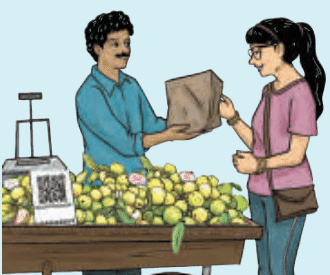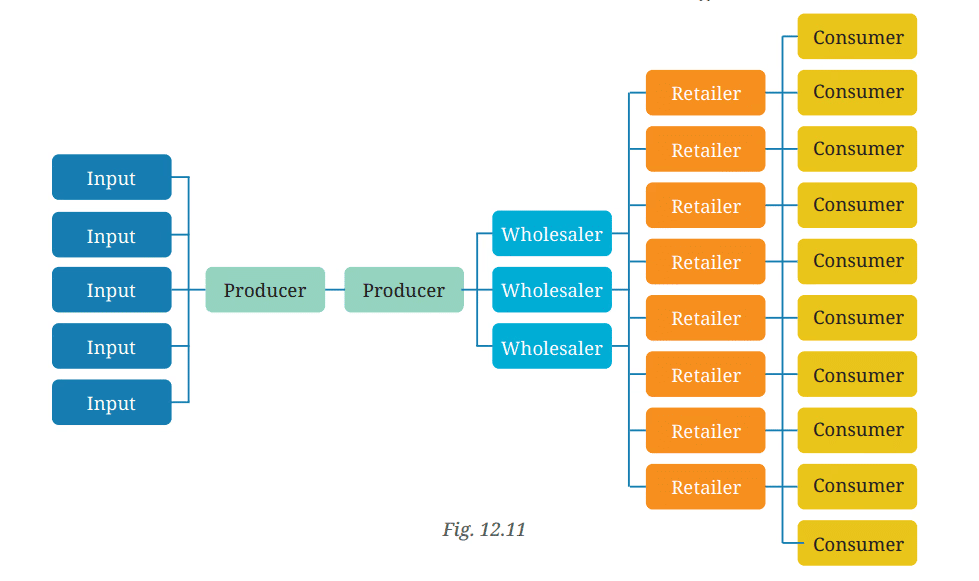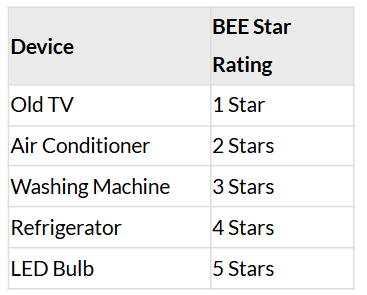Class 7 Social Science Chapter 12 Let's Explore - Understanding Markets
Page 251: What is a Market?
Q: Can you imagine what this bazaar must have looked like during its peak? Do you know of any old markets from your state? How would they be similar or different from today's markets? Discuss with elders in the family and community.
Ans: Hampi Bazaar at Its Peak: The Hampi Bazaar during the Vijayanagara Empire was vibrant, bustling with traders selling grains, silk, animals, gems, and cotton cloths, as described by Portuguese travelers. Imagine crowded streets opposite the Virupaksha temple, with colorful stalls, craftsmen working openly, and diverse goods like rubies and pearls, creating a lively, prosperous scene.
Old Markets in Your State: Examples depend on the student’s region, e.g., Johari Bazaar (Jaipur, gems, page 259) or Khari Baoli (Delhi, spices). Discuss with elders to identify local markets, like Chennai’s George Town or Kolkata’s New Market.
- Similarities to Today’s Markets: Both have buyers and sellers negotiating prices, diverse goods, and cultural exchange (e.g., Ima Keithal).
- Differences: Old markets were physical, lacked online options, and had fewer regulations. Modern markets include digital platforms, standardized certifications, and global supply chains.
Q: Observe the illustration. What are these people discussing? Imagine you and your partner as a buyer and a seller of guavas. Prepare a set of dialogues between both of you and present it in your class as a skit.
Ans: Illustration Discussion (Fig. 12.4): The people are likely negotiating the price or quality of goods (e.g., guavas), as markets involve buyer-seller price agreements (page 251). They might discuss quantity, freshness, or discounts.
Skit Dialogues (Buyer and Seller of Guavas):
- Buyer: “How much for these guavas? They look fresh!”
- Seller: “₹80 per kg, best quality from my farm!”
- Buyer: “That’s high! Can you make it ₹60?”
- Seller: “₹60 is too low, I’ll lose money. How about ₹70?”
- Buyer: “Okay, ₹70 works. Give me 2 kg.”
- Seller: “Deal! Here’s your guavas, freshly picked.”
- Presentation: The skit should show negotiation, reflecting market dynamics (page 252), with students acting out bargaining to reach a mutually agreeable price, emphasizing price as a key transaction feature.
Page 252 to 257: Think About It
Q: Can you think of a type of market where negotiation is less common and why?
Ans: Market Type: Fixed-price markets, like supermarkets, malls, or online platforms (e.g., Amazon, page 254), have less negotiation.
Why:
- Standardized Pricing: Prices are pre-set based on costs, demand, and competition, displayed on tags or websites, leaving little room for bargaining.
- Scale of Operations: Large retailers handle high volumes, making individual negotiations impractical.
- Consumer Expectation: Buyers expect fixed prices for convenience and transparency, unlike haats where bargaining is cultural (page 251).
This contrasts with weekly markets where negotiation is common due to flexible pricing (page 252).
Q: Vegetables are sold cheaper late at night at the weekly market compared to during the day. Why do you think this is so? Garment stores offer heavy discounts on woollen clothing at the end of the winter season. Why does this happen?
Ans: Vegetables Cheaper at Night:
- Perishability: Vegetables spoil quickly, so sellers lower prices late at night to clear stock before it becomes unsellable (page 258).
- Reduced Demand: Fewer buyers visit late, prompting discounts to attract sales.
Discounts on Woollen Clothing:
- Seasonal Demand: Demand for woollens drops post-winter, so stores discount to clear inventory and avoid storage costs.
- New Stock Preparation: Retailers make space for summer clothing, reducing prices to sell off winter items.
These reflect supply-demand dynamics, where excess supply or low demand lowers prices (page 265).
Q: What do you think are the pros and cons of online and physical shopping respectively? Explore this question from the point of view of both, sellers and buyers.
Some services require in-person contact like tailoring and cannot be provided online. Can you suggest other services where physical markets are needed?
Ans: Pros and Cons of Online vs. Physical Shopping:
Buyers:
- Online Pros: Convenience, wider variety, home delivery, price comparisons (page 254).
- Online Cons: Cannot touch/try products, delivery delays, risk of fraud.
- Physical Pros: Immediate purchase, quality inspection, personal interaction (page 254).
- Physical Cons: Limited variety, travel time, higher prices in some cases.
Sellers:
- Online Pros: Reach global customers, lower overheads (no physical store), data-driven sales (page 254).
- Online Cons: High competition, platform fees, logistics challenges.
- Physical Pros: Direct customer relationships, immediate sales, no delivery costs (page 254).
- Physical Cons: High rent, limited reach, inventory management.
Services Requiring Physical Markets:
- Haircuts (salons, page 259).
- Medical consultations (hospitals).
- Repairs (e.g., shoe or watch repair).
- Fitness training (gyms).
These require in-person expertise or equipment, unlike online services like tutoring (page 254).
Q: Observe the diagram and describe the flow of goods from the manufacturer / producer to the consumer. What is the role of the wholesaler and the retailer in the flow?
Ans: Observation as follows:
- Wholesaler: Buys goods in bulk from producers, stores them, and supplies smaller quantities to retailers, ensuring wide distribution and stock management (pages 257–261).
- Retailer: Sells goods in small quantities directly to consumers, providing accessibility and building customer relationships (pages 258–259).
- Flow: Producer → Wholesaler → Retailer → Consumer (Fig. 12.11, page 257).
Page 262: Wholesale and Retail Market
Q: Ask your nearest retailer about a product, its place of origin, and the chain of suppliers in the process of the product reaching the shop. Trace this using a flow chart like Fig. 12.11 and share it in class.
Ans: Retailer Inquiry: Students should ask a local shopkeeper (e.g., grocery or clothing store) about a product, like rice or a shirt. Example: For rice, the retailer might say it originates from a Punjab farm, supplied via a wholesaler in a nearby mandi.
Flow Chart (Based on Fig. 12.11, page 257):
- Producer: Farmer grows rice in Punjab.
- Wholesaler: Buys rice in bulk at a mandi, stores it in a warehouse.
- Distributor: Transports rice to local retailers.
- Retailer: Sells rice to consumers in a shop.
- Consumer: Buys rice for household use.
- Sharing in Class: Present the flow chart, explaining each step, e.g., “Rice travels from Punjab farms to our shop via wholesalers in Delhi.” This reflects the supply chain from producer to consumer (pages 257–259), like the Surat textile market (page 260).
Page 263, 265 & 266: How markets benefit society
Q: Consumers prefer to buy refrigerators that use less electricity. When a large number of consumers begin to ask for refrigerators that use less electricity, what do you think happens in the network you saw in Fig. 12.11?
Ans: Impact on Supply Chain (Fig. 12.11, page 257):
- Consumers: Demand energy-efficient refrigerators, influencing retailers.
- Retailers: Report higher demand to wholesalers/distributors.
- Wholesalers/Distributors: Request more energy-efficient models from manufacturers.
- Manufacturers: Produce more refrigerators with higher BEE Star ratings (page 269) to meet demand, adjusting production to focus on energy-efficient designs.
- Outcome: The market responds to consumer preferences, increasing the supply of energy-efficient refrigerators, benefiting society by reducing electricity use and environmental impact (page 264). This shows how demand drives supply in markets (page 265).
Q: Have you observed any such practices in your community or neighbourhood? Describe the practice as a drawing or in a short paragraph.
Ans:
- Local Practices: Students should identify community market traditions, like the South Indian practice of giving free haldi and kumkum (page 265). Example: “In my neighborhood, vegetable vendors gift a small bunch of curry leaves with purchases, symbolizing goodwill.”
- Description (Paragraph): “In our local market, fruit sellers often add an extra apple or banana to the bag for regular customers, a gesture of kindness. This builds trust and encourages customers to return, showing how markets foster relationships beyond transactions.”
- Drawing: Sketch a vendor handing over free curry leaves with vegetables, labeled with “Goodwill Gesture.”
This reflects markets’ non-economic role in building community ties (page 264), similar to Ima Keithal’s cultural exchange.
Q: Onions are an important part of the cuisine in most parts of India. In some seasons, the supply of onions comes down in the market. What do you think happens to the price of onions when this happens?
What will happen if the people supplying onions do not bring the required quantities to the market? What do you think the government should do in this situation?
Ans: Price When Supply Decreases: When onion supply drops (e.g., due to poor harvests), demand exceeds supply, causing prices to rise (page 265). Example: Onions may jump from ₹30/kg to ₹80/kg, as buyers compete for limited stock.
If Suppliers Don’t Bring Enough Onions:
- Shortages occur, further increasing prices, making onions unaffordable for many.
- Consumers may switch to alternatives (e.g., shallots), or markets may face unrest.
Government Actions:
- Price Control: Set a maximum price to protect consumers (page 265).
- Import Onions: Source onions from international markets (page 255) to boost supply.
- Subsidies: Provide farmers incentives to grow more onions next season.
- Stock Release: Distribute stored onions from government warehouses to stabilize prices.
These interventions balance supply and demand, ensuring fair pricing and availability (page 265).
Page 269: Providing Public Goods
Q: Check out the BEE Star labels on the electronic devices in your home and make a chart of all the devices in an increasing order of their energy efficiency.
Ans: BEE Star Labels: Students should inspect devices (e.g., fridge, AC, TV) for BEE Star ratings (1 to 5 stars, page 269). Higher stars indicate greater energy efficiency.
Chart Example (Increasing Order of Efficiency):
Process: List devices, note star ratings from labels, and arrange from lowest to highest stars. If no label exists (e.g., old devices), assume lower efficiency. This exercise teaches students to assess energy efficiency, aligning with consumer quality checks (page 269).
Page 263: Think About It
Q: We have discussed different dimensions of markets. Can we imagine what life might be like without markets? What would happen if farmers did not bring rice, wheat, dal, vegetables and fruits to the market? What would happen if the producers of cloth in Surat could not procure inputs like cotton from markets?
Ans: Life Without Markets: Without markets, people would rely on self-production or barter, limiting access to diverse goods and services (page 263). Life would be challenging, with reduced economic and social interactions.
No Farmer Produce: If farmers don’t supply rice, wheat, dal, or vegetables (page 263):
- Food shortages would cause hunger and higher prices.
- Households would struggle to meet basic needs, disrupting daily life.
No Cotton for Surat Producers: If Surat’s textile market lacks cotton (page 260):
- Production of fabrics and garments would halt, affecting wholesalers, retailers, and exports.
- Artisans and workers (e.g., 1.5 million in Surat’s diamond industry, page 262) would lose livelihoods.
Markets are essential for connecting producers and consumers, ensuring goods availability (page 263).
Q: Aakriti is a professional artist who creates oil paintings on canvas. Her paintings are appreciated, but she finds it difficult to find buyers. She is worried about where to sell the paintings and what price she should offer them for. Unlike the case of guavas, there are fewer local buyers and sellers for artwork.
Can you think of other products which do not have a ready market? How does it affect those willing to buy or sell? What are the different ways in which artists can find buyers for their work today?
Ans: Products Without Ready Market:
- Handmade crafts (e.g., pottery).
- Niche artworks (e.g., sculptures).
- Rare collectibles (e.g., antique coins).
- Specialized services (e.g., traditional music lessons).
Impact on Buyers/Sellers:
- Sellers: Struggle to find buyers, face uncertain pricing, and may incur losses or abandon production (like Aakriti, page 263).
- Buyers: Limited access to unique products, higher prices due to scarcity, or reliance on distant markets.
Ways Artists Find Buyers Today:
- Online Platforms: Sell on websites like Etsy or Instagram, reaching global buyers (page 254).
- Art Galleries/Exhibitions: Display work in local or national galleries.
- Social Media: Promote paintings via posts or ads to attract collectors.
- Collaborations: Partner with cafes or businesses to showcase art.
- Crowdfunding: Use platforms like Kickstarter for pre-orders.
These methods leverage digital and physical markets to overcome limited local demand (page 263).
Page 267 & 268: Think About It
Q: The practice of rulers protecting consumers is not a phenomenon of modern India. Kauțilya's Arthaśhāstra includes instructions for the traders trading in clarified butter (ghee). It mentions that buyers shall be given $1 / 50$ part more as mānasrāva to compensate for the reduction in quantity owing to (the ghee)...sticking to the measuring can.
Ans: Historical Consumer Protection: Kautilya’s Arthaśāstra (page 267) shows ancient rulers ensured fair trade by mandating extra ghee (1/50th more) to account for measurement losses, protecting buyers from shortfalls.
Implications: This reflects early market regulation, similar to modern government roles (page 265), ensuring trust and fairness. It highlights a historical emphasis on consumer welfare, preventing exploitation by traders, akin to today’s weight and measure checks (page 267).
Q: What are the other areas where you can see the government being involved in the markets? Are there areas where government intervention needs to be reduced? Discuss with family or relatives.
Ans: Government Involvement in Markets:
- Subsidies: Providing affordable fuel or fertilizers to farmers (page 265).
- Taxation: GST on goods/services to regulate revenue.
- Licensing: Approving food or drug production (page 266).
- Environmental Regulations: Banning single-use plastics to reduce pollution (page 266).
- Public Distribution System: Supplying subsidized food grains via ration shops.
Areas for Reduced Intervention:
- Over-Regulation: Excessive licensing can burden small businesses, stifling innovation (page 267).
- Price Controls: Overly strict caps may discourage production (e.g., low drug prices reducing supply, page 266).
- Bureaucracy: Complex import/export rules can delay international trade (page 255).
Discussion: Students should talk with family, e.g., “My uncle says too many permits slow down his shop’s expansion.” This balances government’s role in fairness (page 265) with market efficiency needs.
Q: There is a marbles competition in your neighbourhood with the team in the next street. You want to buy new marbles for the competition. You have ₹150 saved up. You go to a shop to buy the marbles. What are the qualities you would look for in the marbles so that you can win the competition?
Ans: Qualities to Look for in Marbles:
- Size: Medium-sized marbles for better control and aim.
- Strength: Hard, durable material (e.g., glass or steel) to withstand impacts.
- Weight: Balanced weight for accurate shots.
- Color/Design: Bright, distinct colors for visibility and appeal.
- Price: Within ₹150, ensuring quality without overspending.
- Rationale: These qualities enhance performance in the competition, ensuring marbles are effective and reliable. This reflects consumer quality assessment, similar to checking certifications like FSSAI (page 269).
|
23 videos|204 docs|12 tests
|
FAQs on Class 7 Social Science Chapter 12 Let's Explore - Understanding Markets
| 1. What are markets and why are they important in our economy? |  |
| 2. What are the different types of markets that exist? |  |
| 3. How do supply and demand affect market prices? |  |
| 4. What role do consumers play in the market? |  |
| 5. How do markets impact our daily lives? |  |





















